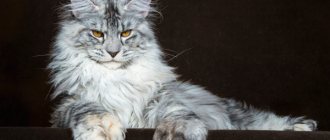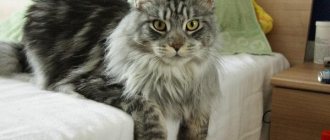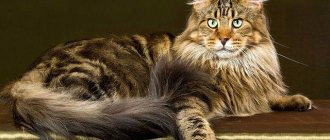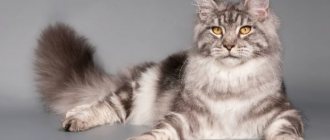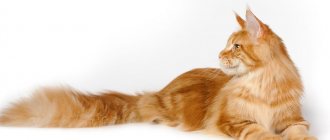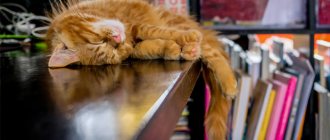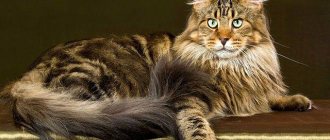Maine Coon domestic cats are spoken of only in superlatives. They are the largest, heaviest, longest, most affectionate, laziest, and also the oldest in the United States.
The pedigree of Maine Coons causes some controversy, but only in terms of how the ancestors of these giant cats came to the American continent.
And their subsequent migration to Europe and the division of the breed into two branches - the indigenous American and the new European - remain in the sphere of interests only of true connoisseurs and professional experts.
What are Maine Coons: types of breed
Despite the fact that the first Maine Coons appeared in the United States, European breeders took part in the development of the breed. Thus, certain breed characteristics inherent in modern representatives were fixed. This was the reason for the appearance of two types of Maine Coons: American and European. Representatives of these subspecies differ from each other in breed characteristics and character. What types of Maine Coons are there, read below.
Description of the American type breed standard
There is an opinion that the Maine Coon is a hybrid of the Manx raccoon and a domestic cat. Genetically this is unlikely, but cats have some similarities with wild raccoons.
The main breed characteristics of the American Maine Coon type:
- Long body and large bones;
- Wide variety of colors. Only chocolate, ticked and point colors are prohibited for breeding, which may indicate interbreeding;
- Thick fur in the collar and panties area. Nature invented this feature to protect cats from the harsh North American climate;
- Fluffy and long tail.
Aboriginal representatives of the breed are distinguished by good health.
Description of American type standard:
- Body: large, rectangular with a wide chest;
- Paws: medium length, round, muscular;
- Tail: long, wide at the base, tapering towards the tip;
- Coat: thick, long, close to the body, waterproof;
- Eyes: wide-set, slanted. The color should look harmonious with the color;
- Head: massive, square. The skull is powerful, the cheekbones are high. The chin, nose and upper jaw form one line;
- Ears: Large, with a wide base, tapering to the tips. The distance between the ears is equal to the width of the base of one ear. A characteristic feature is the presence of tassels;
History of selection and features of the European cat variety
European breeders decided to create an “extreme” breed of cats, based on aboriginal cats. But, despite the efforts of breeders, the European type of Maine Coon has its own mutations, due to which these cats differ from the classical standards.
European look
The appearance of European Maine Coons in the 70s of the 20th century led to the formation of a separate type of representatives of this breed. European cats have significant differences from the aborigines - the work of breeders to consolidate certain traits in their pets provoked their distance from the original type and the manifestation of extreme traits. The goal of the breeders is to achieve maximum difference from the American type, this determines the main characteristics of the “Europeans”:
- long body;
- elongated, tapered muzzle;
- low forehead;
- long ears with tassels;
- high paws;
- long tail reaching to the shoulder.
An important difference between Maine Coons of the European type is their slanted eyes, the shape of which makes the look of these cats predatory and gives them a proud look. “Europeans” do not have such a thick and silky coat as the aborigines, but their beautiful solid smoky color makes them popular among cat lovers.
At the beginning of the selection breeds, “Europeans” were distinguished by fragility and excessive grace, but over time this problem was solved.
How to distinguish an American Maine Coon from a European one
It is difficult for the average person to distinguish one type of coon from another. But, there are some features by which you can determine which branch the animal belongs to. Here are the main ones:
- “Americans” have a shorter torso than “Europeans”. But, their physique is denser.
- Aborigines are endowed with smaller ears than “extreme” people;
- The American Maine Coon has a more powerful chin and a curved profile;
- The look is kinder than that of a European;
- If you see a Maine Coon of tabby color, it means that he is American.
It follows from this that the indigenous breed is a classic, and the Europeans are a modern breed.
Differences
Fans of the American Maine Coon type make every effort to preserve the natural qualities of the breed, while adherents of the “Europeans” strive to change the features of the traditional appearance of these cats and finally consolidate these changes.
The main differences between European-type cats and Aboriginal cats:
- longer body;
- elongated, almost triangular muzzle;
- oval, set far apart eyes;
- large, high-set ears, decorated with lush tassels;
- less voluminous coat, lack of a thick mane and lush “pants” on the paws;
- The color is most often a solid smoky color rather than a patterned tabby or agouti.
One look at the representatives of the European type makes it clear that these cats are decorative pets, reminiscent of a lynx, and not hunters - rat catchers, like the American Maine Coons.
The character of the “American” and the “European”
Maine Coons are cats and dogs. Unlike other breeds, they love to spend time with their owner, bathe, and carry objects in their teeth.
Representatives of both branches, despite their attachment to the owner, value their independence. They love affection, but cannot stand intrusiveness. Constant squeezing is not for them. When guests come to the house, these cats can play, but they will not get into your hands.
Coons are quite active cats. They love to run and jump, so they require a separate play area in the house. Peak activity is morning and evening. They spend the day on the couch. American representatives of the breed love to play with balls and toy mice, as they are hunters by nature. “Europeans” love to lie on the sofa and have their tummy scratched.
How the breed appeared
The Maine Coon breed is considered indigenous. It got its name in honor of its homeland - Maine. The breed began to form 2 centuries ago. Its first representative was shown in 1861 at exhibitions in Boston and New York.
For a long time, Maine Coons were inferior in popularity to exotic Siamese, Persian and Oriental cats. They looked like wild forest animals, and the breed did not arouse much interest. Maine Coons managed to survive thanks to farmers who preserved their phenotype.
Over time, they regained popularity. They began to be actively exported to other countries and demonstrated at exhibitions. In the second half of the twentieth century. Maine Coons found their way to different European countries. In France, the first Maine appeared in 1981, and in Russia - in 1989. The standard was adopted in 1967, but the breed was first registered in 1908 in the CFA felinological federation.
Today Maine Coons are at the peak of their popularity. There are many nurseries breeding them; new breed types appear. But the main tasks for felinologists are to preserve the integrity of the breed and improve it in accordance with modern tastes.
How to care for representatives of both types of Maine Coons
In terms of care, the Maine Coon is a difficult breed. To keep your pet healthy and happy for a long time, you must follow the following rules:
- Feed only high-quality food or natural food. There are special foods in the Royal Canin or Brit line, developed specifically for this breed. For those owners who prefer natural food, you need to understand that 80% of a cat’s diet consists of meat and meat by-products.
- To prevent your pet from getting sick, it is necessary to vaccinate once a year.
- Long and thick hair requires constant care with special combs and shampoo.
- You need to bathe your cat once a month. If your pet goes outside, it needs to be regularly treated for fleas and other parasites.
- For healthy fur, teeth and claws, your pet needs vitamins. The best option is to crush it and put it in your mouth—coons don’t like to eat tablets.
Cat character and behavior
The temperament of Maine Coons from the USA and Europe is no different. Good-natured pets treat children and other pets well if they do not pose a threat to their health. Cats respond to aggressive behavior with a hiss, but rarely attack or get into a fight. The calm nature allows Maine Coons to withstand the strong hugs of children.
Cats are easy to train, especially in childhood. They have a well-developed memory, so they quickly remember basic commands, gestures and distinguish the owner’s emotions by the intonation of his voice.
Despite their sociable nature, sometimes cats want to be alone. To do this, they need to allocate a personal space where the animals can rest. After 1-2 hours they will be ready to communicate again.
Maine Coons are active, require a lot of attention and happily come into contact with new people. They are curious and can play for a long time. Cats have a pleasant voice. Pets choose only one of the family members as their owner, but treat the rest with the same affection. They obey only the owner.
Health Features
A purebred Maine Coon tolerates low temperatures well, but leaving your pet in the cold for a long time is dangerous due to frostbite of the ears, paws and tip of the tail. Animals are also susceptible to various bacterial or viral diseases if vaccination is ignored. The Maine Coon's breathing fluctuates up to 40 breaths per minute. If a cat sleeps with its mouth open, this may indicate overstimulation of the nervous system after active games or increased temperature in the room. However, if your pet has a dry nose, intermittent or shallow breathing mixed with hoarse sounds, upset bowel movements, lack of appetite or desire to play, this is a reason to contact a veterinarian.
Proper care and nutrition will ensure good health for your pet, however, Maine Coons may exhibit genetic diseases.
Pets are in good health, but the following pathologies may occur:
- Cardiomyopathy. Characterized by pathological changes in the heart and cardiac muscles.
- Hip dysplasia. It is considered a genetic pathology in which the joint is formed incorrectly and the head of the femur does not fit into the acetabulum.
- Spinal amyotrophy. A genetic disorder caused by dysfunction of spinal cord cells, resulting in muscle weakness and paralysis.
Coat and color
Maine Coons are semi-longhaired cats. They have thick, shiny and silky fur.
Guard hairs on different parts of the body have different lengths. The short ones cover the area of the head, shoulder blades and limbs, the longer ones grow closer to the tail. The belly, sides, “pants” and “collar” are quite fluffy.
The undercoat is well developed. It is soft to the touch, quite dense and waterproof.
Color – natural, varied. The most common wild colors are black and red marble, black tiger. In Russia, Maine Coons are often white and have various shades of agouti.
Artificial colors (lilac, chocolate, colorpoint, sorel, fawn) are not recognized by most felinological organizations, since they may be the result of interbreeding.
A characteristic feature of cats of this breed is thick and long hair! Short guard hairs grow only on the head and paws of the animal.
If a short-haired or smooth-haired individual is offered under the guise of a Maine Coon, it is likely that it is not a purebred.
Comparison with lynx
Maine Coons are large, powerful cats that look like a wild animal. A large elongated body with a square face, in which bright, slanted eyes and high-set large ears with pussies at pointed ends resemble a predatory lynx. The domestic mini-lynx has no biological connection with the wild animal except for its external resemblance.
Comparison with Norwegian forest
These breeds, at first glance, do not differ much from each other in comparison. Both breeds are large animals with long, thick fur, but the main differences are:
- The difference is most noticeable in the shape of the head, which is clearly visible in profile:
- The Maine Coon has a head with a wedge narrowed at the bottom and a lowered forehead.
- The Norwegian Forest Cat has a triangle-shaped head with a flatter forehead.
- Thick coat, although both breeds have a silky coat similar to the touch with water-repellent properties:
- The Norwegian Forest Cat has a dense, double coat of fur. The neck is decorated with a chic frill.
- The Maine Coon's coat is coarser and unevenly distributed over the body. It is shorter at the shoulders, and has a less dense and shorter undercoat.
- The breeds' tails look excellent and fluffy, but there are differences:
- The Norwegian cat has a long tail that narrows towards the bottom and ends in a cone.
- The Maine Coon's tail grows long hair all the way to the tip.
Appearance Features
A purebred Maine Coon has the appearance of a predator, thanks to its bright slanted eyes, large, widely spaced ears, it is emphasized that it sees and hears everything perfectly, like a real hunter. A square, slightly elongated muzzle indicates adaptability to hunting and the ability to obtain food from burrows.
How to distinguish the Maine Coon breed from the mestizo by external characteristics; for this you need to take into account only their inherent features:
- The body is elongated, almost horizontal, square in shape. Wide, powerful skeleton covered with well-developed muscles. The body is continued by strong limbs of medium length with large rounded paws with hair between the claws.
- The tail gives the coon a special appearance. Long, fluffy along its entire length, it covers the entire back when folded. The end is blunt at the base, and the tail itself is thick, without kinks.
- The head is of medium neck length, slightly elongated in length compared to the small body. The muzzle is square in shape and has a powerful chin. The wide forehead smoothly turns into a nose with a small notch, which is decorated with a long mustache.
- Maine Coon ears are special, set high, quite large, pointed, and wide at the base. The main distinguishing feature of the ears is the presence of tufts at the ends, like those of a lynx.
- The raccoon cat has a special coat that is adapted to any weather conditions. Soft, it falls in long strands along the entire back and tail, creating a fluffy mane on the chest.
The largest representatives
Maine Coons, the largest species, are one of the largest animals in the cat family. From the history of breeding, a coon is known whose weight reached 15 kg. Many breeders deliberately overfeed their pets in pursuit of larger sizes; as a result, the animals suffer, they develop diseases associated with obesity, and their life expectancy is reduced.
Important! The organizers of the Maine exhibition competitions had to cancel the prizes for the title “The Fattest Cat”.
The raccoon cat breed is the leader not only in weight, but also in body size. The record length is 132.2 cm for the coon from Nevada, recorded in the Guinness Book of Records. For these cats, lengths up to 120 cm are not uncommon.
Dimensions and weight
The growth period of a kitten can last for 3-4 years; the Maine Coon grows slowly, and gradually by the age of five it looks like a powerful, large animal similar to a lynx. An adult pet can reach an average length of 110 cm, and together with the tail reaches up to 145 cm. Cats are not only long, but also tall, reaching up to 40 cm at the withers.
Important! In achieving the enormous size of a pet, not only genetics plays an important role, but also proper care, a balanced diet, regular visits to the veterinarian, and compliance with the vaccination schedule.
Polydacts
Genetic mutation - polydactyly is inherited. This is a rare deviation from the norm; an ordinary cat has five toes on its front paws and four on its back paws. An anomaly of six or seven fingers passes from the parents and does not depend on the sex of the animal. For the Coon breed:
- It is acceptable to have polydactyls, but this is much less common today. Animals born with polydactyls cause interest and surprise.
- It has been established that the anomaly is caused by a natural mutation and does not affect the usefulness of the six-fingered pet.
- The manifestation of polydact depends on the presence of an autosomal dominant gene in coons. When mating a Maine Coon and a regular cat, if the partner has such a gene, then in 50% of cases it manifests itself at the birth of kittens.
- When two non-polydactic partners are mated, the kittens are born with a normal number of toes, which means that the gene is passed on from the parents and not from ancestors through generations.
Tassels on ears
Coons have tassels on the tips of their ears; this is a distinctive feature of the breed that belongs only to them, making them look like a wild lynx. According to breed standards, a Maine Coon without ear tufts is recognized by the rules, is not considered a defect, and also participates in exhibition shows.
The fact is that the growing undercoat on the inside of the ear can be of different sizes and stick out outside the shell with any height and density.
Maintenance and care of Maine Coons
Keeping a Maine Coon at home is quite an expensive pleasure. Whether it is an apartment or a private house does not matter, since this breed of cats came from wild ancestors who were accustomed to nature.
It is very important to toilet train a small raccoon cat; this usually does not cause any problems.
It would also be a good idea to purchase accessories and toys that the Maine Coon loves. Cats of this breed have quite a lot of energy, so they will only enjoy all kinds of games.
Accessories
Tray. For the Maine raccoon cat, it is better to choose a closed tray, about 35x50 cm in size with high sides. It is advisable to place a large bed in front of the toilet.
A bowl. To feed Maine Coons, you should choose a bowl that is also large and has a wide bottom, like for dogs.
Drinking bowl. The ideal water bowl would be a special cat fountain, since Maine Coons love water very much and can play with drinking water for a long time.
Scratching post. If you don’t want your furniture to get damaged, be sure to pick up a scratching post for your raccoon cat. It is very convenient to use a special play complex for this purpose, in which the cat can both frolic and sharpen its claws.
You can make such a house with your own hands, using old furniture and available materials.
Toys. The best toy for a Maine Coon is a rubber ball or a wooden toy.
Tray closed
Food bowls
Drinking fountain
scratching post
Grooming
It is very important to properly care for the fur of a Maine Coon cat: wash it as often as possible and comb it so that the hair on the inner parts of the body does not roll into tangles.
It is better to start combing with a wide-toothed comb, and as the cat gets older, switch to a brush.
Shedding
The first molt occurs in kittens at the age of 5-7 months. If the fur comes out in large clumps, it is recommended to use special shampoos and conditioners. In addition, to maintain good coat condition, it is very important that the cat eats properly.
How to choose a kitten?
Small Maine Coon kittens must have the characteristics of the breed - a powerful body structure, erect ears with tassels, a characteristic muzzle shape. It is not desirable for kittens to be clearly smooth-haired. A small cat of the pet class is intended for home keeping. It has a mixture of external inconsistencies with the standard. The babies of the breed class have an elite cat pedigree and breed characteristics that are interesting for breeders. A show class cat is considered a show cat because it has all the features that the Maine Coon breed has. A healthy kitten is playful, with a lively look, clean fur, and no discharge from the eyes and nose. Adulthood in such animals occurs late, around 3-5 years.
